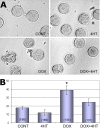Challenges and Potential for Ovarian Preservation with SERMs
- PMID: 25810474
- PMCID: PMC4645985
- DOI: 10.1095/biolreprod.115.128207
Challenges and Potential for Ovarian Preservation with SERMs
Abstract
Tamoxifen (TAM) is a selective estrogen receptor modulator with tissue-specific effects on estrogen signaling used predominantly for treatment and chemoprevention of breast cancers. Recent studies have shown that TAM prevents infertility and decreases follicular loss from common cancer chemotherapy and radiation therapy in preclinical models. Here we review current and novel uses of selective estrogen receptor modulator s and advantages and challenges for translation of TAM for human fertility preservation.
Keywords: SERM; cancer; fertility; ovary; tamoxifen.
© 2015 by the Society for the Study of Reproduction, Inc.
Figures


References
-
- Mahran YF, El-Demerdash E, Nada AS, Ali AA, Abdel-Naim AB. Insights into the protective mechanisms of tamoxifen in radiotherapy-induced ovarian follicular loss: impact on insulin-like growth factor 1. Endocrinology. 2013;154:3888–3899. - PubMed
-
- Gleicher N, Kushnir VA, Barad DH. Therapeutic interventions into early stages of follicle maturation: a new treatment paradigm after over 50 years of modern infertility therapy. Endocrinology. 2013;154:3498–3501. - PubMed
-
- Falcone T, Attaran M, Bedaiwy MA, Goldberg JM. Ovarian function preservation in the cancer patient. Fertil Steril. 2004;81:243–257. - PubMed
-
- American Cancer Society. Global Cancer Facts & Figures, 2nd ed. Atlanta, GA: American Cancer Society; 2011.
Publication types
MeSH terms
Substances
LinkOut - more resources
Full Text Sources
Other Literature Sources

